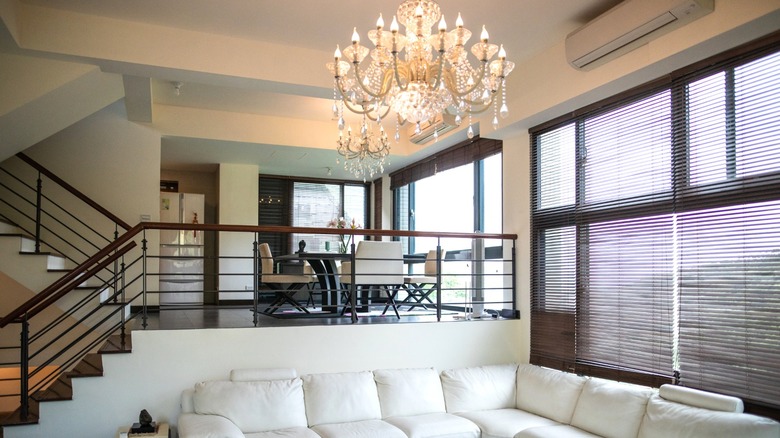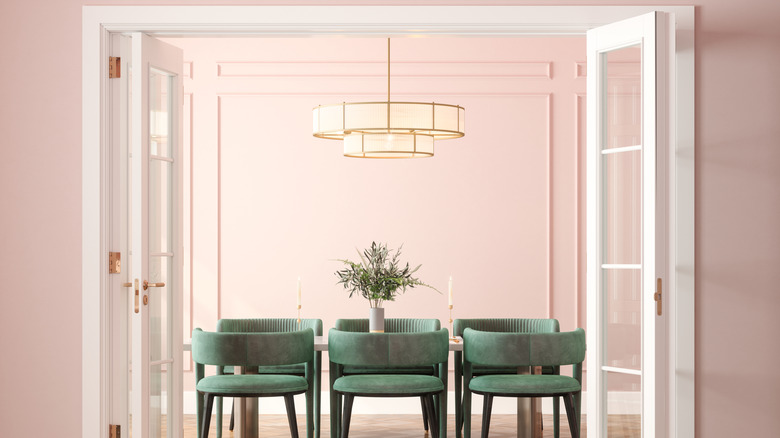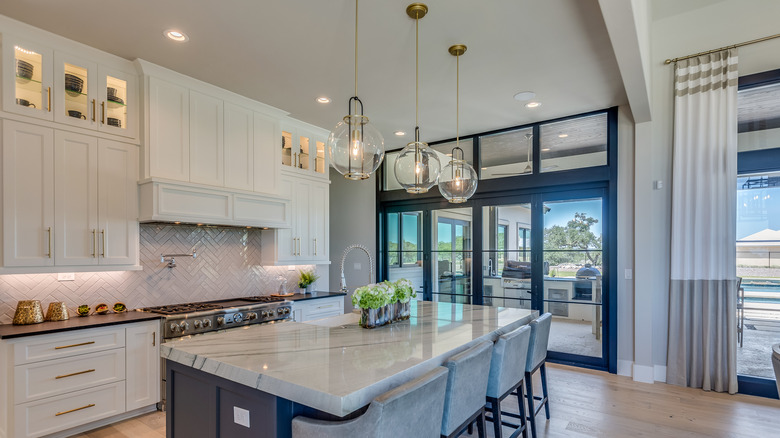Despite What Some Say, Here's How The Big Light Continues To Stay Prevalent In Our Homes
Interior designers agree most rooms need furniture you can sink into, art that feels personal, and rugs to tie it all together. But debate surrounding central lighting rages on, as many Gen Zers and Millennials argue the "big light" is a big problem. You know the one we mean. It's that giant LED box in the kitchen you've been meaning to replace, the show-stopping chandelier in your entryway, or, yeah, that builder-grade ceiling fan situation going on in your guest room. Perhaps you've got yours on a dimmer. Maybe you've forbidden your family to ever turn it on. Either way, we've all got 'em. And according to Erika Dale, House Digest's interior design expert and Founder of Erika Dale Interior Design, the big light is here to stay despite what some say, especially now that many have figured out how to incorporate it into a balanced lighting scheme.
"Big statement lights are stunning and never really went out of style," Dale told House Digest in an exclusive interview. "A fabulous chandelier is always going to be fabulous!" The big light is better than ever, as more people realize they should avoid overloading them with high-wattage bulbs or relying on them as the only light source. "People started putting them on dimmers and creating layers of light to create a better mood or ambiance," she explained. Although overhead lighting is an ancient concept, Dale attributed the "big light" concept to the invention of the electric lightbulb, which in turn led to the popularization of ceiling-mounted fixtures. "In the many years since, designs ranging from ornate chandeliers to slim flush mounts became available as both practical and decorative elements in a home." Rather than come and go as trends change, the big light evolves alongside shifting needs, technologies, and styles.
Using chandeliers to add a wow factor without overdoing it
"Though the singular 'big light' approach to lighting a room has been prevalent in decades past, homeowners in recent years are moving away from the often overly-harsh singular source of lighting to a more layered, subtle, balanced lighting scheme made up of various light fixtures," Erika Dale said during her exclusive interview with House Digest. When you want to add some interest to a room, oversized fixtures are an obvious choice. But according to Dale, the addition of dimmers that allow for controlled lighting to set the mood is what keeps the "big light" center stage in so many homes.
Showy designs are one "big light" approach interior designers absolutely love, and with plenty of great crystal chandeliers available for under $200, they're an accessible option for many. "Chandeliers are like the jewelry of a space, adding a bit of luxury and glamour to elevate a room," Dale explained. She added that they can work anywhere you want to make a strong impact, from your entryway to over a kitchen island, but cautioned that you should consider chandeliers a decorative element rather than rely on them for functional task lighting. And, there are also some places a chandelier simply doesn't work. "Rooms with low ceilings may not have the height necessary to pull off a large chandelier, meaning the wrong-sized fixture could throw off the whole aesthetic and scale of the room," Dale said. Since multiple "big lights" in open concept floor plans may find themselves competing for attention, she also recommends using large chandeliers sparingly to ensure a more impactful look.
Layer in accent and task lighting to add interest
It can be quite the challenge to get good lighting in every room in your home, but Erika Dale offered several tips during her exclusive House Digest interview. "Scale plays a huge part in overhead lighting, as anything too under- or oversized is going to look off," she explained. "Ceiling height, sizing of any furniture pieces below the fixture (dining table, island, etc.), and general room dimensions are all going to be factors in selecting the correct light size."
If you do decide to embrace the "big light," you should also plan on keeping things layered. "As most statement fixtures are not designed to provide all-encompassing room lighting unless totally blown out with painfully bright bulbs ... chandeliers are most successful when left to be twinkling ambience," Dale said. She highly recommended dimmers, calling them "your best friend" no matter what mood you want to create. Dale also recommended layering in ambient and task lighting. She suggested features like under-cabinet lighting in kitchens, vanity lights in your bathrooms, and, of course, well-placed lamps anywhere you love to curl up and read. To keep illumination totally balanced, Dale also said to consider adding decorative accent lights, pointing to fireplace sconces and art lighting as examples of ways to bring plenty of visual interest to the space.


